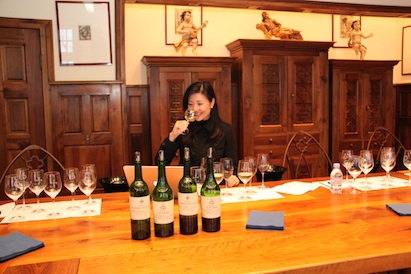
The first time I met Professor Hildegarde Heymann in 2004, I was very excited. Here was the woman who was taking over sensory research pioneered by Professor Ann Noble at the University of California Davis. Anyone seriously attempting to study wine aroma will have come across Ann Noble’s Wine Wheel. This handy wheel encapsulates the seemingly daunting world of wine aromas in a concise, easy to understand display of major and minor flavor categories.
I had made an appointment in 2004 with Professor Heymann, who is still with UC Davis, as a Master of Wine student trying to understand the world of flavor descriptors and trying to glean tips on how to be a master taster. Professor Heymann is a tall curly-haired woman whose smile and face resembles a grown-up Pippi Longstocking. She had just joined the faculty the year before and was very friendly, bringing me up-to-date on the department’s latest research and we discussed the concept of a ‘supertaster’, a term that was being tossed about during the wine circles at the time.
She confided that she herself was a ‘non-taster’, someone who could not pick up on certain phenolic compounds which are easily detectable for those who are ‘supertasters’. I was eager to take this test and very soon after my meeting with Professor Heymann, I had the opportunity. I was told to place a wooden stick in my mouth that contained certain phenolic flavor compounds to see if I could taste it. As soon as I placed the stick in my mouth, I gagged and reached for a glass of water. It was bitter and disgusting. This gag reflex was the sign of a ‘supertaster’. Others around me tasting the same favour-infected stick had different reactions – some chewed on the stick and were only mildly bothered by its flavours while others kept chewing, curious as to why they could not taste anything at all. This latter group was under the ‘non-taster’ category.
It hardly seems fair to be labeled a ‘non-taster’ just because one cannot detect a group of phenolic flavor compounds. Many so-called non-tasters are brilliant wine makers and excellent tasters. The problem with this supertaster test is that it only focuses on the identification of a select group of phenolic compounds while there are plenty of other clues as to the wine’s identity and quality. However, for a wine lover this information is useful to know. We can be more aware of how sensitive (or insensitive) one is to red wine’s quality and quantity of tannins.
One other thing that Professor Heymann did was examined my saliva glands and declared, “Very good. You show promise as a wine taster.” Apparently those who have healthy saliva glands produce sufficient saliva to cleanse the palate and cope with palate fatigue in large tastings. She suggested that it was important to rest between large flights, after every six or so wines and drink as much water as possible.
I know this is the sensible thing to do, but in reality this is difficult. In large wine competitions or tastings where over 100 wines are tasted in a day, drinking water can really slow you down. Consuming water between tastings is also controversial amongst wine professionals – there are those who swear by no water between tastings for accuracy and others who swear by copious amounts during tasting. Michael Hill-Smith, who is the first Australian Master of Wine and head of numerous wine judging competitions around the world, believes consuming water between tastings exaggerates the tannic fur-ball feeling in the mouth. Others like Professor Heymann believe in copious amounts of water between tastings for maintaining a fresh palate.
I fall into the when-my-mouth-cries-out-for-water-I-need-to-drink camp, and this week, while I am in Singapore tasting over 100 wines per day for Singapore Airlines, I will be rinsing my mouth when my mouth feels stuffed with cotton balls or when the acidity has painfully whipped my tongue. However, at the pace of 30 wines an hour (2 minutes per wine), taking a gulp of water is a luxury. Thank goodness for my robust saliva glands!
Reprinted with permission from the South China Morning Post









